
Phra Somdej BangKhunProm
In the late reign of the King Rama 4, a clerk named Duang Dhanakoses had reconstructed the monastery of Wat Mai-Amataros. The same time he also constructed a new Chedi here for great merit. The construction started in 2411 (1868) and lasted in 2413 (1870).
In this construction, there were both of large and small Chedis. The large for filling the Buddha amulets by ancient motto for succeeding the religion of Buddhism. The small Chedi for filling the ancastors bones. When the construction was finished , Mr. Duang asked for permission to Somdej Phra Buddhachan (Toh) Promrungsee for making the Buddha amulets to fill in the large Chedi of Wat Mai-Amataros.
Somdej Toh gave some of sacred powder (same as used in making of Phra Somdej Wat Rakhang) to use for ingredients to make the Buddha amulets. Somdej Toh also pronounced incantations on these newly made amulets. After that he filled all of amulets into the large chedi.
The main ingredient of these amulets is lime. The amulets were made in square shape same as Phra Somdej Wat Rakhang. The amount of Buddha amulet was named “Phra Somdej Bangkhunprom” by the name of sub district where the Chedi was located.
The age of Phra Somdej Bangkhunprom is not far from Phra Somdej Wat Rakhang. But the mould is different due to different groups of the sculptors. Anyhow, both of two Buddha amulets had the same outline. Phra Somdej Bangkhunprom was divided in 9 variations according to image styles.-
• Pim Phra Prathan or Pim Yai
• Pim Kate Buatoom
• Pim Song Chedi
• Pim Sendai
• Pim Thansam
• Pim Sangkati without ear and with ears
• Pim ProkPoh
• Pim ThanKhu
• Pim Ok Krud.
The Chedi which filled by Phra Somdej Bangkhunprom amulets was 3 times in officially opened.
• First in 2425 (1882)
• Second in 2436 (1893)
• Third in 2459 (1916)
Phra Somdej from all 3 times were called “Phra Somdej Bangkhunprom Kru Kao” (Old Pagoda) These amulets skin was so smooth less of scarf-skin.
After the 2nd World War, there were often illegal diggings the Chedi to find the amulets. So, the authority of Wat Mai-Amataros had to declare opening this Chedi officially to bring out all of amulets. General Prapas Jarusatiean, Interir Minister, was invited to be the chairman in this ceremony in November 27, 2500 (1957). The amulets from the latter opening were called “Phra Somdej Bangkhunprom Kru Mai”. (New Pagoda)
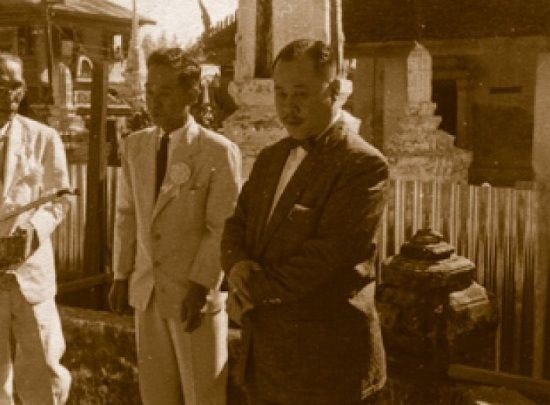
General Prapas Jarusathiean was the Chairman in opening ceremony on November 27, 2500 (1957) of Kru Mai

Most of this amulets were thick scarf skinned by the reaction of moisture and lime. Due to amulets were found on the base of the Chedi which was often under flooded. Many of the founds were ruinous by the people who did furtively incorrect methods which left the amulets in good condition just about 3,000 pieces. Phra Somdej Bangkhunprom were distributed to the public for worship. The income from the worship was used for reconstruction of the monastery. The price rate is 500-2,000 Bath. This price was recognized very high in that time.
In summary, Somdej Bangkhunprom is divided into two categories: Kru Kao (Old Pagoda) and Kru Mai (New Pagoda). This was because prior to the year B.E.2500, a small group of collectors however could not wait for official pagoda opening and alas they sneaked into Wat Mai Amataros and stole a small number of these amulets.
In order to differentiate the Somdej Bangkhunprom, antique Buddha collectors held a meeting and agreed to name the amulets brought out before B.E.2500 as Somdej Bangkhunprom Kru Kao (old pagoda). Whereas the amulets brought out officially by the monastery was named as “Somdej Bangkhunprom Kru Mai” (new pagoda). Actually whether it is Kru Kao or Kru Mai, their qualities are the same and their value for collection is no different.
Another point for differentiation of Phra Somdej Bangkhunprom Kru Kao and Kru Mai: Let’s notice in scarf-skin. If there is a lot and thick scarf-skin, it is so called “Kru Mai”. If there is less or non scarf-skin, it is so called “Kru Kao”
The votive tablets brought out from the pagodas can be divided into three types namely Top of Pagoda, Middle of Pagoda and the Bottom of Pagoda. The votive tablets that were extracted out from the top of pagodas are less affected by weather and rain conditions. Therefore the surface is sturdier and the lines and forms of the amulet images are more visible. These have the most collection value.
Amulets that are brought out from the middle section of pagodas are mostly yellow or brown in color. A small number of amulets from this middle section would even have water corrosion marks or exhibit crack marks. Their value therefore must be in proportions to the extent of corrosion found. The more corroded amulets will fetch lower value whereas in better condition in the case of those light yellow or golden yellow in color could fetch prices not lower than the amulets brought out from the top of the pagodas.
Finally, the amulets that were extracted out from the bottom of the pagodas are usually the most cored ones where most are broken or not even in shape. There would of course be a small number of amulets which are not affected by the conditions inside the pagodas. Although these amulets have been buried for many years, are still in good condition. The value of these amulets are thus higher and if they are truly beautiful, their value could even be comparable to the amulets brought out from top pagodas. However these incidences are rare. To conclude, amulets brought out from the bottom of the pagodas usually fetch the lowest prices.
How to classify between Somdej Wat Rakhang and Somdej BangKhunphrom
Phra Somdej Bangkhunprom is the second most popular of Buddha amulets after Phra Somdej Wat Rakhang. In the family of all three Phra Somdej amulets which Somdej Phra Buddhachan Toh took important part in making were most popular, high price and rare. The people gave faith in holiness not less than Phra Somdej Wat Rakhang which well know for it’s devine blessing power in bringing good-will and amity from encountered people as well as warding-off harms. Someone also believed that drinking water which mixed by the powder from this amulet can cure any illness.
Phra Somdej Bangkhunprom’s mould
• Phra Somdej Bangkhunprom: Pim PhraPrathan
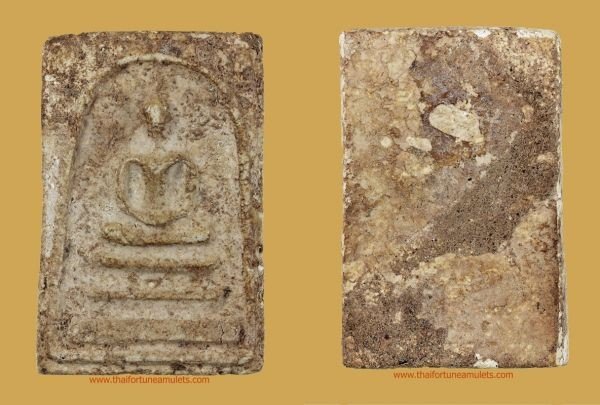
This amulet has many characteristics of the moulds. It’s difficult to classify the groups of Phra Somdej Bangkhunprom Pim Phra Prathan obviously as Phra Somdej Wat Rakhang Pim Phra Prathan. Nonetheless, we can divide this amulet by the entire characteristics such these.-
1. The amulet with large face, thick body. The laying of the left arm was fixed to be an angle style deviating from the body. The elbows ends are over the lap.
2. The amulet with large face, thick body. The laying of the left arm is an angle style but the arm is straight down to the lap. This amulet has the flesh little more over than the joined skin between arm and lap. The entire of this amulet is looked seem slope to the left side slightly.
3. The amulet with medium face, thick body. The laying of the left arm is slightly angle style but the elbow is over the lap.
4. The amulet with medium and small face, the body’s shape is cylinder. Both tow arms are curved laying.
Beside of these groups there are also the type of amulet with small face, slender waisted. The two arms are curved.
• Phra Somdej Bangkhunprom: Pim Kes Buatoom

Pim Kes Buatoom can be divided into 3 types according to variation of moulds.
1. Pim Kate Buatoom Yai, This amulets has large, wide forehead and short chin. The chest is thick but not high bulging. The area of the left armpit was fulled flesh.
2. Pim Kate Buatoom Klang, has large face similar to Pim Kate Buatoom Yai but the chest area is smaller and without the overed flesh under the right armpit.
3. Pim Kate Buatoom Lek, the face of this amulet is convexed and smaller than the two previous types. The body is also smaller thinner and more tapering.
• Phra Somdej Bangkhunprom: Pim Song Chedi was classified into 3 types of the moulds shapes.-

1. Pim Song Chedi Yai, this type can be noticed form characteristics with thick, big body. The amulet also has wide chest and large face.
2. Pim Song Chedi Klang, has the thick and big body but less than the size of Pim Song Chedi Yai. The waist is slender and curved more than Pim Yai. But the face is smaller.
3. Pim Song Chedi Lek, the body is cylinder shape with narrow chest, thick waist. The face is small convexed oval.
• Phra Somdej Bangkhunprom: Pim Sendai was divided into 2 types, Pim Sendai Yai and Sendai Lek by using the entire of the mould structures which different in large or thin. But for in depth study, Phra Somdej Bangkhunprom Pim Sendai can be devided in 4 types according to the characteristics of face, body and arm laying.-
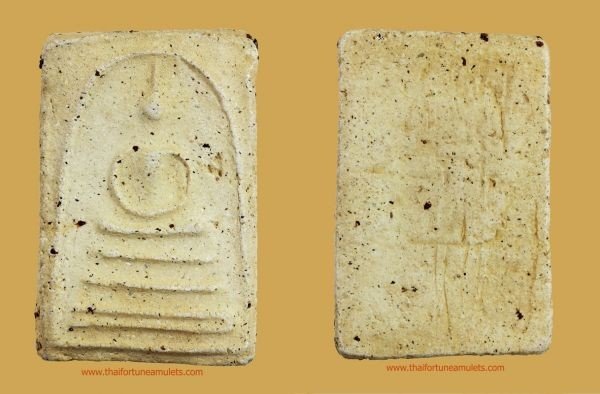
1. Pim Sendai Yai Curved Shoulder, this amulet’s type has the large, swoller rounded face. One of the arm is curved laying and the other is slightly angle
2. Pim Sendai Straight Shoulder has swollen oval face similar to a bael fruit. The chest and shoulder area is wide. The shoulder’s line is straight. One of the arms is curved laying, the other is slightly angle laying The amulet has thick chest, with nearly straight body. This type of amulet has joined flesh between the angle arm and the lap on the left side.
3. Pim Sendai Curved Shoulder, small face. This type has small rounded face. The body is thin shoulder and arms stretch is narrow. The arms laying is curved.
4. Pim Sendai Straight Shoulder, small tapering face. This type has nearly tapering thin face. The body is thick and large in cylinder shape. The right arm is curved laying. The left arm was found in both slightly angle laying or nearly straight angel.
• Phra Somdej Bangkhunprom Pim Thansaem has tapering body. The Buddha amulet’s ears are long nearly reach to shoulder. There are lines insert between the first step and the second step of the base. Thes lines are clearly noticed. So this type of amulet was called “Pim Thansaem” characteristic of the base since the ancient time. And there is a line of Sangkati lay on through of the Buddha’s body.
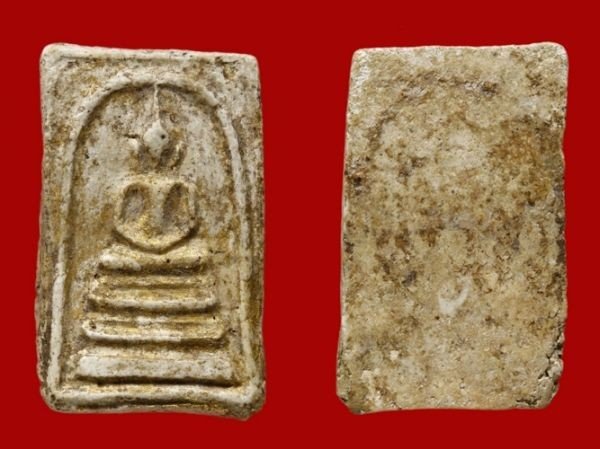
1. Pim Ok Naa, large face straight shoulder with both tow arms Laying in angel style, This amulet’s type is robuster than other moulds in the same group of Pim Thansaem. The chest is high bulging with clogged flesh. It’s looked smart and graceful. The body and waist are tapering. The line of Sangkati can be noticed so clearly.
2. Pim OK Naa, medium face with angle arms. The characteristics of the type are similar to the first type. But the face and chest are smaller.
3. Pim Ok-Rong, small face, this type of Buddha amulet has the thinner shape than others types. There is deep ditch split on throughout the body of Buddha and small face.
• Phra Somdej Bangkhunprom Pim Sangkati was divided into 2 types such as Phra Pim Sangkati with ears and Pim Sangkati without ear. Because of this type of Buddha amulet were made from several moulds. The differences of the moulds in on the ears of Buddha amulets. At this time we will not recognize others compositions which also important for classification of Buddha amulets moulds.

1. Pim Sangkati without ear, the remarkable of this type besides of special characteristics with the line of Sangkati laid on through the body of Buddha amulet and characteristic of the base that was claimed before. The most important of this amulet’s type is the Buddha has no ear to be noticed.
2. Pim Sangkati with ears, the usual characteristics are same as the first type but the difference between the two is the latter Buddha has the ears on the rims of face which can be noticed obviously.
3. Pim Pises (Special type) This type has some characteristics related beween Phra Pim Sangkati and other types. Especially, the often found is the mixed by Phra Pim Kate Buatoom. (The face and upper body is similar to Pim Kate Buatoom but the base is characterized to be Pim Sangkati. This special type was called Pim Ti-Toom)
• Phra Somdej Bangkhunprom Pim Thankhu was made from several moulds that made the characteristic details of each mould. Anyhow, the type of this amulet can be grouped like this

1. Pim Ok Noon, the Buddha amulet in this type has the convexed chest. The ditch on the Buddha’s chest is not run through out of the body. The Buddha’s face has the size from medium to large face.
2. Pim Ok Talord, The Buddha amulet in this type has the chest with ditch through out of the body. This remark was found in both types of straight body and type of deviating body. Phra Pim Ok Talord is the most amulets which were found in type of Pim Thankhu.
• Phra Somdej Bangkhunprom Pim Ok Krud was divided into 3 types.-

1. Pim Ok Krud Yai, The Buddha in this type has the large face, convexed thick chest with tapering body. The entire characteristics of this Buddha amulet is the bigger body more than other types.
2. Pim Ok Krud Klang has small face than the first type but the body is robuster. The body’s shape is cylinder with full flesh. The entire looking this Buddha’s body is shorter and smaller.
3. Pim Ok Krud Lek, The entire looking of this Buddha amulet is smaller than the first two types. The face is smaller the chest is not convexed and the body is thinner.
Somdej BangKhunProm - Kru ChediLek (small pagoda)
From historical record, in B.E. 2411, Samiean TraDuang Thanagoses built a small pagoda in Wat Bangkhunprom for the purpose of keeping bone of his own family. He also created Phra Somdej in 6 different moulds which were buried in Phra Chedi Yai (Large Pagoda). These six pim are: Pim SamLiamNahMhon (Triangle base), Pim YuenPrathanporn (bless in standing posture), Pim Samadhi (concentration), Pim Saiyas (laying down posture), Pim Thankhu (double base) and Pim ChediWheakMahn. He invited Somdej Toh of Wat Rakang to place all amulets, bless and empower in Chedi Lek (small pagoda).
1. Pim SamLiamNahMhon (Triangle base)

2. Pim YuenPrathanporn (bless in standing posture)
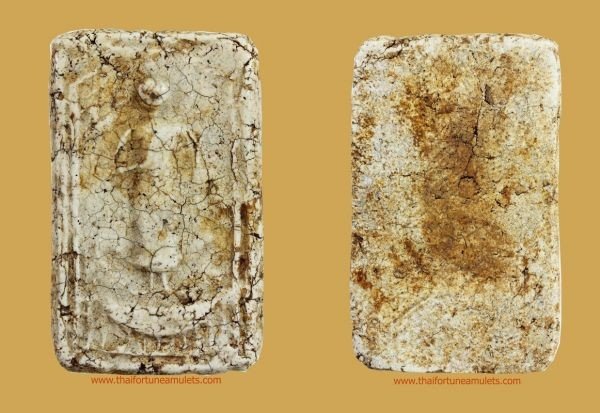
3. Pim ThanMohn (sitting in meditation posture)
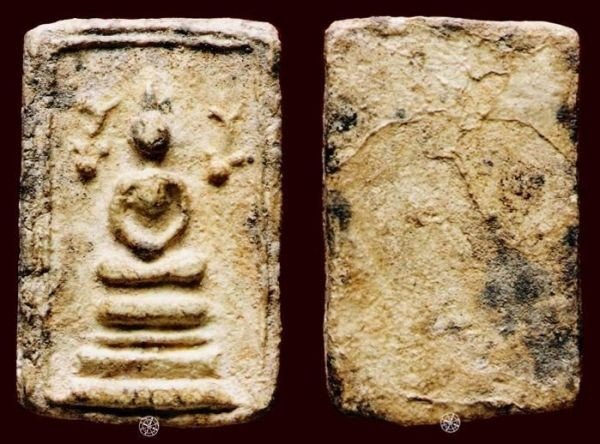
4. Pim Saiyas (laying down posture)
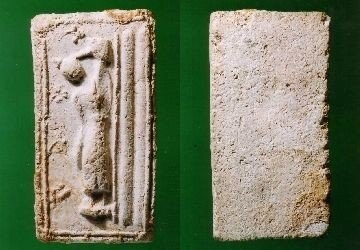
5. Pim Thankhu (double base)

6. Pim Phra Chedi or ChediWheakMahn. (curtain and pagoda)

In B.E. 2506 (A.D.1963), Small pagoda had been broken due to temple maintenance and restoration. At that time, temple official found assets of ancestors and many amulets in various moulds which were contained in pagoda altogether. Firstly, the amulet collectors were not interested in, as time gone, amulets were analyzed sacred materials and miraculous effect happened directly to the worshipper. This results the collectors turning back to be interested. At the present, amulets from Kru ChediLek is very popular and rare which equal to Somdej Bangkhunprom Kru ChediYai due to there were proved that amulets were blessed by Somdej Toh and using same sacred materials with amulets in Kru ChediYai.
Most of sacred materials were the same used for the Phra Somdej Wat Rakang and Wat Bangkhunprom in Kru Phra ChediYai (Kru Kao) but only mould was different. Loosely granulated materials are seen on the surface. What we see on the surface of the amulet under 10X magnified lens comprising sacred powder, white gravel materials of lime compound, charcoal from ground burnt shell (black), ground sun-dried rice, ground brick (red spots) ground dried flowers (brown), and ground burnt-incense stick (black) are floating on. Tung oil and honey was well mixed and homogeneously cemented.